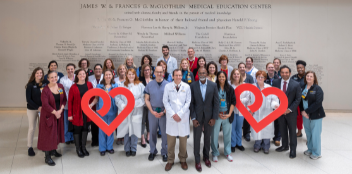Kukreja and Das Receive $2 Million NIH Grant
 Rakesh Kukreja, PhD
Rakesh Kukreja, PhD
 Anindita Das, PhD
Anindita Das, PhD
In 2004, former VCU Health Pauley Heart Center Cardiac Catheterization Lab Director George Vetrovec, MD, was giving a lecture on PCIs using stents that eluted rapamycin. He explained that the drug helped prevent plaque from rebuilding in arteries following the procedure. Sitting in the audience, Pauley Scientific Director Rakesh Kukreja, PhD, pondered that the agent might have other benefits as well.
“I was listening to George’s lecture and I thought, ‘Maybe this drug has a cardioprotective effect,’” recalls Kukreja.
They were pleasantly surprised to find that the drug did indeed protect the heart from delving into failure following an acute myocardial infarction. “We were the first ones to show it,” he says.
To find out, he and Anindita Das, PhD, and other colleagues conducted an animal study. They were pleasantly surprised to find that the drug did indeed protect the heart from delving into failure following an acute myocardial infarction. “We were the first ones to show it,” he says. Greeted at first with some skepticism, the innovative research is now widely referenced in other studies.
That work, published in the Journal of Molecular Cardiology in 2006, led Das and Kukreja to further studies, along with a growing interest on the role rapamycin could play in diabetes.
“Type II diabetes is one of the biggest epidemics in the world. And anyone whose fasting glucose levels are high, they are three times more prone to death by heart attack than an average person,” says Kukreja. “Dr. Das was very excited working in this field of diabetes, and she thought she could take the concept of heart protection with rapamycin into diabetic models. She has done a tremendous job in leading the project and generating beautiful data.” He adds, “In fact, Dr. Das is one of the most talented and hard-working scientists I have ever worked with in my entire career. The success of this project would not have been possible without her painstaking efforts.”
The data revealed that, in the diabetic heart, an enzyme known as Complex 1 mTOR (mechanistic target of rapamycin) had very high activity and promoted heart failure. Based on those findings, the pair postulated that rapamycin, an mTOR inhibitor, could help to minimize the damage—and now they will have the chance to explore the premise with the help of a $2 million+ NIH RO1 grant.
With the new study, which began in July but is the result of a body of work 12 years in the making, “We wanted to see the molecular, mechanistic part—discover more detail about how rapamycin is protecting the heart against myocardial ischemic injury,” says Das, an assistant professor. The NIH study will use both cellular and translational models to explore how the modulation of mTOR provides cardioprotection over both the long term and following the acute injury following a severe heart attack.
“Our aim is to protect that heart cell; in particular in diabetic conditions, where the cells are dying due to lack of oxygenation and high glucose.”
Heart cells do not regrow following injury, she says. “So even if one cell is dying, it is a huge loss for the heart. Our aim is to protect that heart cell; in particular in diabetic conditions, where the cells are dying due to lack of oxygenation and high glucose.”
Interestingly, rapamycin is also being used to prevent tumor growth in cancer patients. Kukreja projects it will not be long before rapamycin or its novel analogues will be also available to diabetics.
“We believe that by the end of our studies, within the next two to three years, we should have sufficient, compelling data to start the clinical trials in diabetic patients,” he says.
Back to Summer-2016
Join our Pauley Consortium composed of patients, friends and advocates.

